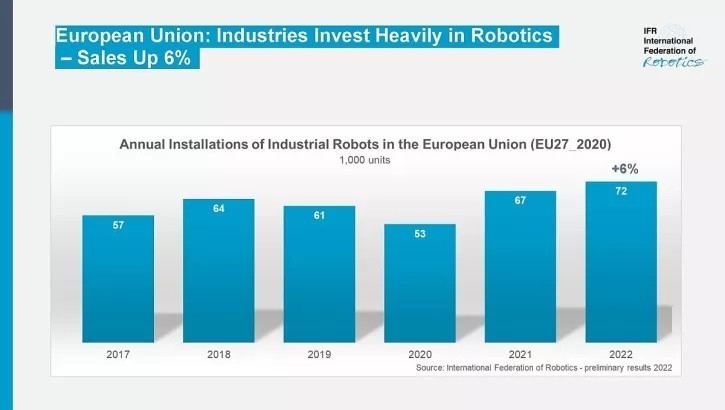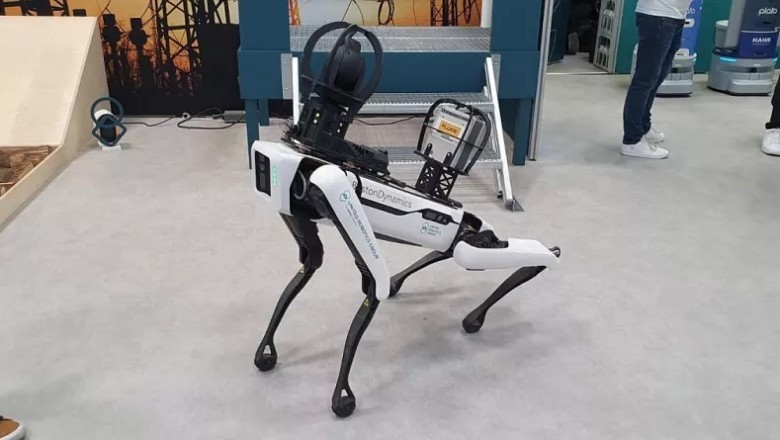EU Member States Continue Strong Investments in Robots
In Europe, there is a significant increase in demand for industrial robots, with the 27 member states of the European Union installing approximately 72,000 units in 2022, reflecting a 6% increase compared to the previous year.
According to Marina Bill, President of the International Federation of Robotics (IFR), "The five largest user countries of industrial robots in the EU are Germany, Italy, France, Spain, and Poland. Together, they account for around 70% of all installations in the EU in 2022."
Germany stands out as the largest robot market in Europe, with approximately 26,000 units set to be installed in 2022, representing a 3% increase compared to the previous year. This accounts for 37% of the total number of robots in the EU. Globally, Germany ranks fourth in terms of robot density, following Japan, Singapore, and the Republic of Korea.
"The robotics and automation industry is on a growth trajectory," affirmed Frank Konrad, Chairman of VDMA Robotik + Automation, during a press conference prior to Automatica 2023.
The automotive industry traditionally remains the primary consumer of industrial robots in Germany. In 2022, 27% of newly deployed units were installed in this sector, totaling 7,100 units - a 22% decrease compared to the previous year. This reduction reflects the well-known cyclical investment behavior in this segment. In the general industry, the main consumer was the metal industry, which installed a total of 4,200 units in 2022, representing a 20% increase. This surpasses the pre-pandemic level of around 3,500 units per year, with a peak of 3,700 units in 2019. Installations in the plastic and chemical industries have reached pre-pandemic levels again, with a 7% increase to 2,200 units in 2022.

The significant investments in industrial robots across several sectors in Europe demonstrate the growing importance of automation and robotics in enhancing productivity, efficiency, and innovation. These machines have the potential to revolutionize various industries, improving manufacturing processes, reducing costs, and increasing competitiveness. As industries continue to adopt automation technologies, Europe's demand for industrial robots is expected to keep rising.
Furthermore, the advancements in robotics and automation have implications beyond the industrial sector. These technologies have the potential to address societal challenges, such as an aging population, healthcare, and environmental sustainability. With ongoing advancements in artificial intelligence and machine learning, robots are becoming increasingly intelligent and capable of performing complex tasks with precision and accuracy.
As the demand for industrial robots continues to grow, it is crucial for policymakers, industry leaders, and educational institutions to collaborate and ensure a skilled workforce capable of operating and maintaining these advanced machines. Additionally, continuous investment in research and development is essential to further enhance the capabilities and applications of robotics in various sectors.
With Germany leading the way, European countries are demonstrating their commitment to embracing automation and robotics as key drivers of economic growth and competitiveness. As technology continues to evolve and new possibilities emerge, Europe is poised to remain at the forefront of the global robotics industry, strengthening its position as a technological powerhouse.
In conclusion, the robust investments in robots across EU member states reflect the increasing recognition of their benefits in various industries. With Germany as the leading market, Europe is well-positioned to capitalize on the potential of automation and robotics. As this technological revolution unfolds, Europe's commitment to innovation and embracing automation will contribute to its long-term success and prosperity in the global economy.






















Comments
0 comment